#Muromachi shogunate
Video
20230626 Nukata 5 by Bong Grit
Via Flickr:
お地蔵様の石像の前にちっちゃいお地蔵様がたくさん。 @Tenonji temple, Nukata area, Okazaki city, Aichi pref. (愛知県岡崎市額田地区 天恩寺)
#Jizo#Stone statue#Stone#Statue#Green#Nature#Plant#Tenonji temple#Tenonji#Temple#Buddhism#Muromachi era#Muromachi shogunate#Rinzai school#Zen buddhism#Nukata#Nukata area#Okazaki#Aichi#Japan#Nikon#Nikon Df#COSINA#COSINA Voigtländer NOKTON 58mm F1.4 SL2 N#flickr
18 notes
·
View notes
Text
Most formal outfits for upper ranks samurai - Sokutai and Ikan formal court dress
(as worn by upper-ranked samurai of the Edo period - great charts by Nadeshico Rin). You can find more about samurai ranks and their regulated attires under the tag "samurai kimono".
The Sokutai
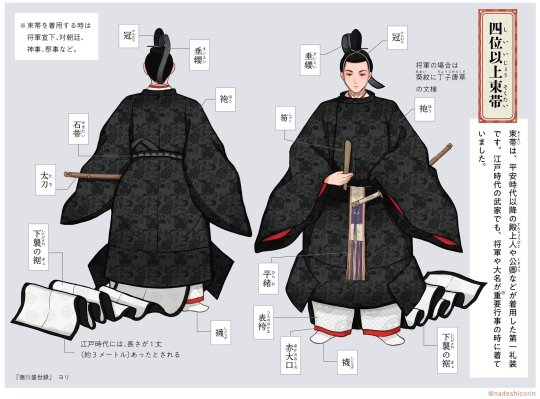
束帯 Sokutai is the most formal attire worn by Edo period samurai of the 4th rank and above.
It first appeared during Heian era as a ceremonial court dress worn by 公卿 kuge (nobility/Imperial court) and 殿上人tenjôbito (courtiers/court officials). Usage was kept well into Edo period by both the Imperial court and the Tokugawa shogunate.
The intricated garb includes:
冠 Kanmuri - hat, with distinctive 垂纓 suiei "tail" hanging in the back. Materials could include silk, lacquer or horsehair and were strickly regulated
袍 Hô - a round-necked robe with large boxy sleeves. Colors and patterns were strickly regulated.
Shown here is a pattern used by the Shôgun, the 葵に丁子唐草 Aoi ni chôji karakusa (cloves with arabesques, and hollyhock leaves - which is the Tokugawa crest)
笏 Shaku - flat ritual sceptre
平緒 Hirao - a wide flat braid wrapped around the body with ties left hanging up front. Colors and weaves were strickly regulated
(飾)太刀 (Kazari)-Tachi - (mock) long sword for ceremonial use
表袴 Ue-no-bakama (or omote-bakama) - white overpants, shorter hakama pants worn over the aka-ôkuchi
赤大口(袴) Aka-ôkuchi(bakama) - red underpants, a tad longer than the overpants
下襲(の裾) Shitagasane(no-kyo) - visible train part of an inner robe worn under the 袍 hô. During Edo period, train lenght got up to 1丈 (around 3 meters/10 feet).
襪 Shitôzu - a type of ancient socks (construction is different than tabi - they don't have a sole for ex.)
石帯 Sekitai - leather belt used in ceremonial court dress, covered in black lacquer, and decorated with stones and jewels
The Ikan

衣冠 Ikan - while still very formal and worn by Edo period samurai of the 4th rank and above, ikan looked much more simpler than sokutai.
First used for nightime duties (夜間宿直) in Heian era, it gradually came to be worm during daytime too. From Muromachi period and onwards, it had become the work uniform of the Imperial court.
Like sokutai, it uses the hô+kanmuri, and wearers were allowed to carry kazari-tachi. Yet, note how the pants differ from sokutai ones: those are large bouffant pants called 指貫 sashinuki (or 奴袴 nubakama).
You can also note that wearer here is not holding a shaku scepter: it's a folded 檜扇 hiôgi (formal folding fan made of cypress also of Heian history. Those were unpatterned as painted ones were for women).
#japan#fashion#fashion history#nadeshico rin#samurai kimono#samurai#buke#warrior class#sokutai#ikan#edo period#edo era#heian period#reference#ressources#men kimono#着物#Kanmuri#Hou#Shaku#Hirao#Tachi#Ue-no-bakama#omote-bakama#Aka-ôkuchi#Shitagasane#Shitôzu#Sekitai#Ikan#sashinuki
287 notes
·
View notes
Photo

Shogun
The shoguns of medieval Japan were military dictators who ruled the country via a feudal system where a vassal's military service and loyalty was given in return for a lord's patronage. Established as an institution by the first shogun proper, Minamoto no Yoritomo in 1192 CE, the shoguns would rule for seven centuries until the Meiji Restoration of 1868 CE. The position of shogun was held by members of certain families which gave their names to two of the three successive shogunate governments (bakufu): the Ashikaga Shogunate (r. 1338-1573 CE) and Tokugawa Shogunate (r. 1603-1868 CE). In the case of the first shogunate, the capital gave its name to the government: the Kamakura Shogunate (r. 1192-1333 CE). The other shogunates may also be referred to by their capitals: Muromachi (Ashikaga Shogunate), an area of Heiankyo/Kyoto, and Edo (Tokugawa Shogunate), the original name of Tokyo.
Continue reading...
72 notes
·
View notes
Note
sorry if it's a dumb question but i've wondered about the nations' skills or what suits their personalities, and who do u think would win in a swordfight between yao and kiku? japan does have such a kenjutsu culture but what about china, since china has a very old history too?
i have thought about this before, actually 🤔 when thinking about pre-modern sino-japanese power dynamics between yao and kiku. personally, i say it actually depends on which point in history. this is my headcanon:
before the kamakura period/shogunate (which overlaps with the sengoku/feudal era of japan) tbh I'd say yao wins. one reason is well, the symbolic power balance between china and japan. the first time china and japan properly met face-to-face in conflict was in the 7th century CE, during the baekje-tang war at the battle of baekgang in korea. long story short: it was a power struggle between korean kingdoms, and the korean kingdom of baekje (yong-soo's brother) was allied to japan, so japan came to help them. their enemy was the other korean kingdom of silla (aka: yong-soo long before he becomes south korea), who...was allied to china. despite being outnumbered 3 to 1, china pretty much crushed japan in that battle. then, kiku is very much an inexperienced upstart challenging the regional hegemon who has far far more notches on his sword. getting wrecked like that by yao is imo, quite a formative experience for kiku (to put it mildly).
but as the centuries go by, yeah no, kiku is the swordsman alright. because of samurai culture, and its elevation to power during the muromachi and edo period. further, there's of course the imjin war, where the samurai lord toyotomi hideyoshi invaded korea with the goal of overthrowing ming china too. even during the successive edo period/tokugawa shogunate, where japan was unified, far more peaceful under isolationism and many samurai became more like bureaucrats, i think kiku continued practising kenjutsu or at least in the form of kendo—swordsmanship and his swords became very much an extension of his personality and identity by then, as well as a way he'd blow off steam even during peacetime. his katana and wakizashi would always be properly maintained and you'd see him carefully oiling it with the mix of mineral and clove oil to prevent rusting, even during the most chill years of edo japan. they'd be nicely displayed like this somewhere in his quarters.

this is compared to how, for all that pre-modern china was an empire and all empires need military violence to expand themselves, warriors as a class in chinese culture never quite ascended to the same type of political prestige as the samurai. it was a very different cultural/political context. it's like, you can't underestimate yao still, as an experienced old empire (tm), but by the 1400s/ming dynasty, i think he might've shifted more to being that kind of general presiding over maps in his military tent, and directing strategy, compared to the younger warlord he was in his earlier years, who was down in the dirt all the time fighting in every single skirmish. so, while yao can and will get his hands dirty if need be with a blade, i think kiku edges him out by then in sheer focus, skill and devotion re: kenjutsu becoming a pretty core aspect of his personality/experiences. to me, it’s also an “old and experienced soldier surpassed by his younger, hungry protégé” dynamic too.
60 notes
·
View notes
Note
live up to your promise. talk about japanese history
Gimme an era:
Heian: 794-1185, the decline of imperial power and the rise of the Samurai class.
Kamakura: 1185-1333, the first Shogunate of Japan and sees the mongol invasions.
Muromachi: 1333-1568, The beggining of Japan's warring states period but it sees no one making clear headway in unifying Japan.
Azuchi-Momoyama: 1568-1600, Japan's warring states period but there are significant warlords now, making significant progress.
Edo: 1600-1868, Ended the warring states period at the Battle of Sekigahara (1600), Tokugawa Ieyasu installs himself as the shogun and begins a 250 year long rule of prosperity in fuedal/early modern (depending on who you ask) japan.
And please keep this in mind: I have written full length essays on two of these periods.
14 notes
·
View notes
Text
what's maybe not good is that my workplace is one of the only places that have ever made me feel welcome. like that's a good thing but I don't want to start thinking about having to work is a good thing like keep it a buck fifty we should have had robots doing it for us while everyone goes home and has sex and makes a lot of art like it's the formation of the ashikaga shogunate in 1336 during the muromachi period
8 notes
·
View notes
Text
Sean bienvenidos, japonistasarqueologicos a una nueva entrega de historia nipona en la que os explico la evolución del artefacto Tanegashima, una vez dicho esto pónganse cómodos, que empezamos.
-
Fue introducido por los portugueses en 1543, en pleno periodo Muromachi desde la isla que lleva su mismo nombre, el polvo negro químico fue inventado por los chinos en el siglo IX, se usaba para los fuegos artificiales, después se trasladó a otros ámbitos.
-
Se cuenta que cuando llegó a Japón, un herrero vendió a su hija para poder producir dicho artefacto, era un producto raro y poco efectivo, no todos los samuráis la utilizaban, ya que muchos preferían, todavía, las técnicas tradicionales más efectivas, además la consideraban un elemento deshonroso. El hecho más notable fue el 28 de junio de 1575 en Nagashino, en la Provincia de Mikawa. El clan de Oda Nobunaga se enfrentaba contra el clan Takeda conocido por su temible caballería, Oda Nobunaga emplearía unas empalizadas para proteger a sus soldados de las sucesivas cargas, en esta batalla se usaría el artefacto en masa. Esto lo podéis ver en el famoso videojuego de Total War: Shogun 2.
-
Esperó que os haya gustado y nos vemos en próximas publicaciones que pasen una buena semana.
-
日本の考古学者の皆さん、種子島の遺物の変遷を説明する新しい日本史へようこそ。 - 室町時代中期の 1543 年に、同じ名前の島からポルトガル人によって導入されました。化学黒色火薬は 9 世紀に中国人によって発明され、花火に使用されましたが、その後他の用途に移りました。地域。 - 彼が日本に到着したとき、鍛冶屋はその工芸品を製造できるように娘を売ったと言われています。それは希少で非効率な製品でした。多くの武士が依然として最も効果的な伝統的な技術を好んだため、すべての武士がそれを使用したわけではありません。彼らはそれを考慮しました不名誉な要素。 最も注目すべき出来事は、1575 年 6 月 28 日に三河国長篠で起こった。 織田信長の一族は、恐ろしい騎兵で知られる武田家と対峙しました。織田信長は連続突撃から兵士を守るために柵を使用しました。この戦いでは、アーティファクトが一斉に使用されました。 これは、有名なビデオ ゲーム Total War: Shogun 2 で見ることができます。 - 気に入っていただければ幸いです。今後の投稿でお会いしましょう。良い一週間をお過ごしください。
-
Welcome, Japanesearchaeologicalists, to a new installment of Japanese history in which I explain the evolution of the Tanegashima artifact. Having said that, make yourself comfortable, let's begin. - It was introduced by the Portuguese in 1543, in the middle of the Muromachi period from the island that bears the same name. The chemical black powder was invented by the Chinese in the 9th century. It was used for fireworks, then it moved to other areas. - It is said that when he arrived in Japan, a blacksmith sold his daughter to be able to produce said artifact. It was a rare and ineffective product. Not all samurai used it, since many still preferred the most effective traditional techniques. They considered it a dishonorable element. The most notable event was on June 28, 1575 in Nagashino, Mikawa Province. Oda Nobunaga's clan faced the Takeda clan, known for its fearsome cavalry. Oda Nobunaga would use palisades to protect his soldiers from successive charges. In this battle, the artifact would be used en masse. You can see this in the famous video game Total War: Shogun 2. - He hoped you liked it and see you in future posts, have a good week.


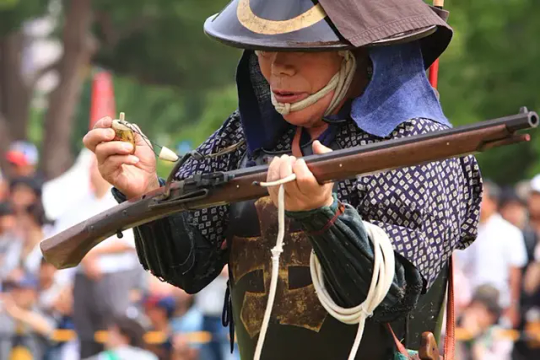
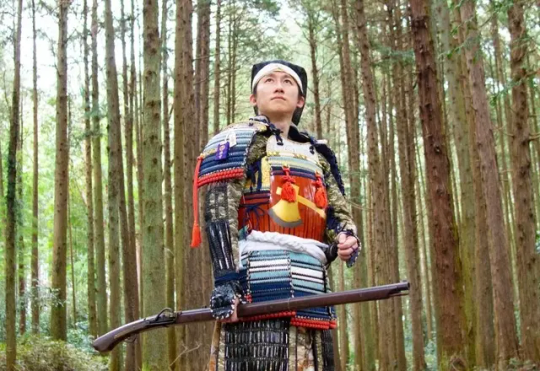


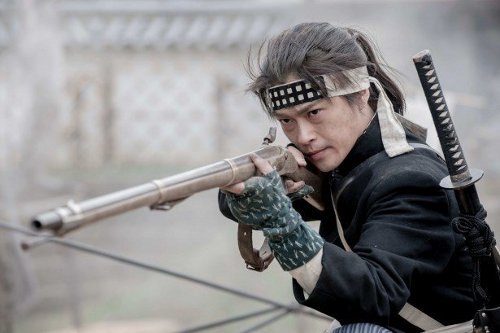
#Japan#History#China#Tanegashima#Hinawashu#NobunagaOgata#Kurantakeda#BattleofNagashino#MikawaProvince#NagashinoCastle#Portugal#MuromachiPeriod#VideoGame#TotalWarShogun2#-#日本#歴史#中国#種子島#日奈和州#緒方信長#倉武田#長篠の戦い#三河#長篠城#ポルトガル#室町時代#ビデオゲーム#photography
18 notes
·
View notes
Text
Fifty Shades of Gray (part 1)
In the mid-Edo period, the Shogunate issued the Ban on Extravagance, prohibiting the wearing of flashy colors such as "beni-iro" (red), so people began to take an interest in colors with low saturation. Brown and gray-colored kimonos were originally thought to be subdued, but wearing them in a chic manner with slight differences in color became very popular. In this context, gray was considered "iki" (fashionable), along with "brown" and "indigo", and in the late Edo period, various derivatives of gray were born, each with a beautiful difference in color tone inspired by trees such as cherry blossoms and willows, nature, historical figures such as "Sen no Rikyu" and "Ono no Komachi," and so on. (source)
The grayish colors popular in the late Edo period, together with the brownish colors popular in the mid-Edo period, were called the "Forty-Eight Browns and a Hundred Grays". Gray colors in particular were popular among young people. (source)
Various gray dyes were used, including yew, plum, oak, and chestnut, all of which were infused and dyed using iron mordant dyeing techniques. One of the reasons for the popularity of various grays in the late Edo period was the easy availability of these dyes. (source)
The name "nezumi" (mouse) refers to gray, like the color of a mouse's fur, and to grayish colors in general. This name originated in the late Muromachi and Edo periods.
Below are summaries of the meanings and histories of 50 types of traditional grays that were commonly used for kimono.
Sunezumi (plain gray) 素鼠 #737373

A representative color of the gray family. A gray color that does not contain any other colors. It's a medium-brightness achromatic color that corresponds to the "重" of the "five colors of sumi ink" (from darkest to lightest: 焦・濃・重・淡・清).
Muromachi period (1333-1573). In the Edo period, brown and gray were especially favored as chic colors, commonly referred to as "forty-eight browns and a hundred grays".
By the way, "素" means "unmixed", and is used in the same way as "bare face" or "bare skin.
Sumi-iro (ink) 墨色 #343434

The color of ink used for calligraphy and painting.
Nara Period.
Sumi ink, which is made by kneading fine quality soot with bittern, has "Five colors of Sumi Ink", or five tones in order from darkest to lightest: 焦・濃・重・淡・清.
Sumi-iro corresponds to "焦", the darkest
Ink dyeing is called "sumizome".
Pine gives it a bluish hue, while rapeseed oil gives it a reddish hue.
Dobunezumi (bowl gray) 丼鼠 #595455

a slightly darker gray color than Sunezumi, similar to the fur color of the gutter rat.
The character for "丼" in the color name was originally written as "溝" (gutter), but the character for "丼" (bowl) is often used to avoid the impression of being unclean.
It is the "濃" color among the "five colors of sumi ink" (焦・濃・重・淡・清), and seems to have been a commonly used color in the mid-Edo period.
Ginnezumi (silver gray) 銀鼠 #BBBCBF

Light gray color with a slight bluish tinge like silver. This color corresponds to the "淡" color in the "Five Colors of Sumi Ink".
Edo period. According to literature from the late Edo period, it seems to have been dyed with a thin indigo dye and an iron mordant dyed with yosotsukeshi.
It's also called "Suzu-iro" because it resembles the color of tin.
Shironezumi (white gray) 白鼠 #DAD7D0

a light gray color that is as elegant as the color of silver. It has been a color name since the mid-Edo period, and was also called "Shironezu" by omitting the end of the word.
This color corresponds to the lightest "清" of the "Five Colors of Sumi Ink", which indicate the shades of sumi ink.
There is no specific information on how to dye shironezumi. However, the name of the dye can be found in the "Konya Isaburo Dye Sample Book" from the mid-Edo period, and it seems to be the color obtained by dyeing the gray color to the lightest shade possible. Incidentally, the method of dyeing gray color is described in "Shoshoku tezome souso" (various colors hand-dyed) as follows: "Make charcoal from eggplant wood, grind it well, and use the wood to dye it, adding a little sesame juice."
Similar to Kinunezu (絹鼠, silk gray)
Komachinezu (Komachi gray) 小町鼠 #E5E2E4

a pale gray color with a slight reddish tinge. This color is paler than "Ginnezumi," and has an elegant and gorgeous appearance. It's one of the gray colors that were popular during the Edo period as part of the so-called "forty-eight browns and one hundred grays".
Originally, this light gray color was not very popular, but the name "Ono no Komachi," a symbol of beauty, gave it the impression of a graceful and beautiful color, so it became a popular color among young people.
Incidentally, it was also during the Edo period that the name "Komachi" came to be used to refer to beautiful women.
Rikyunezumi (Rikyu gray) 利休鼠 #6E7972

Greenish brownish gray.
Edo period.
A color name given in honor of Sen no Rikyu, a man who was popular for stylishness in the Edo period. Not directly related to him, since he's from before the Edo period
The color became widely known through the poem "Rain on Jogashima" (城ヶ島の雨) by Kitahara Hakushu.
Genjinezu (Genji gray) 源氏鼠 #888084

elegant purplish gray
This color name originated in the Edo period. It's derived from Hikaru Genji in "The Tale of Genji".
Among gray colors, purplish gray colors were favored as kimono colors. Purple has been the color of the nobility since ancient times, and the names "aristocratic gray" and "Genji gray" were given to this color in the sense that it is an elegant color. (source)
Koinezumi (dark gray) 濃鼠 #4A474D

Dark gray. Dark gray with bluish-purple tinge.
Edo period. It was dyed mainly with sumi ink and lime water during the Edo period
Also called "koinezu," "konezu," and "konezumi".
Usunezumi (light gray) 薄鼠 #938D98

Pale gray. This light gray has a bluish-purplish tinge.
Edo period.
Usuzumi-iro (light ink) 薄墨色 #8F8F8F

a slightly light grayish color, as if the ink had been diluted
Heian period. Used for mourning clothes and for ink used in obituary letters, and was not a very auspicious color. Incidentally, even nowadays, the color is mostly used for mourning clothes (usuzumi goromo).
It is also called "淡墨色" (light sumi-iro). It has been used as a color name for a long time, even before the color names "nezumi" and "hai-iro" were used.
Hai-iro (ash) 灰色 #9F9D9A

a light gray color, like the ash that comes out when something is burned.
It is sometimes called "nezumi", but strictly speaking it's a different color. "Sunezumi" has a bluish tinge, while "Hai-iro" has a yellowish tinge.
In the Heian period (794-1185), it had a strong image of being an inauspicous color, and was disliked as dull, but in the Edo period, gray colors became popular
Sabinezu (rust gray) 錆鼠 #455659

Blue gray with brownish tints. Dark gray with bluish tints.
Edo period. In the latter half of the Edo period, in addition to the various gray colors that appeared, more colors were added to create a deeper gray.
Gin-iro (silver) 銀色 #C0C0C0

a gray color with a beautiful metallic luster.
Silver is the second most precious metal after gold, which has been loved since ancient times, and they have been compared to the sun and the moon.
It has also been used as a color since ancient times
silver is also called shirogane (platinum) and has the meaning of purity and innocence.
Hakudou-iro (cupronickel) 白銅色 #D3DBE2

a light gray with a slight bluish tinge, like the color of the metal cupronickel (copper and nickel alloy). Although the color is associated with cupronickel, the actual color of cupronickel has a more metallic luster.
The color only started to be used in modern times, and it's a new color introduced in the Meiji era.
Namari-iro (lead) 鉛色 #7B7C7D

a slightly bluish gray like lead.
Lead, also called "aogane," is a pale, soft, heavy metal that is easy to work and highly resistant to corrosion, and is originally a light gray with a metallic luster.
Namari-iro was first used in Japan after the Meiji period.
The dark, heavy impression of lead, such as a lead sky or a lead sea, is often used to describe a sky that looks as if it is about to rain or to depict a gloomy sea.
Suzu-iro (tin) 錫色 #9EA1A3

a bright, almost silvery gray color that is achromatic. Tin is a silvery-white metal.
an older name for Ginnezumi. In the color chart of "Teikan Pattern Setsuyo," it is written, "Suzu-iro, also called Ginnezumi now".
Suzu-iro is a high-class version of Nibi-iro, used for the robe called "Shiyakujo" (錫紵) worn by emperors in mourning for relatives within the second degree of kinship.
Nibi-iro (dull) 鈍色 #5E5E5F

an achromatic, dull gray color.
It has been used since the Heian period (794-1185) and was also called "nibu-iro".
In the past, it was the color of mourning clothes worn when someone close to you had a misfortune.
In later times, it came to be known as the color of iron rust, a bluish gray color with a thin layer of indigo applied to sumizome (ink dyeing).
Incidentally, a color dyed with blue and black dyes such as oak iron mordant is called "aonibi" (blue dull).
Usunibi-iro (light dull) 薄鈍色 #AAAAAA

Light gray.
Heian period.
The color of mourning clothes and monks' uniforms.
It was also used as a color of Japanese paper.
Aonibi (blue dull) 青鈍 #606D69

a dark gray with bluish tints.
It is an old name for a color that was used in the Heian period (794-1185) as the color of clothing for monks and nuns in bad times (inauspicious color).
By the Edo period, dull colors had become fashionable. The color name "Aonibi" was no longer used and was replaced with "Ainezu", and the concept of this color as an "inauspicious color" completely disappeared.
There are two different theories about the dyeing of this color: one says that indigo is lightly overlaid on the gray of white oak bark and acorns, and the other says that the gray is dyed after the indigo is dyed, resulting in very different shades.
Ainezu (indigo gray) 藍鼠 #6B818E

A gray color with an indigo tinge.
Edo period. This color appeared after the mid-Edo period, when a series of gray colors called "48 browns and 100 grays" appeared one after another.
After being dyed with indigo to a light shade of pale blue, it was overlaid with an iron mordant dye made with oak.
Konnezu (navy blue gray) 紺鼠 #3F4551

a dark gray color with a slight blue tinge. Even less bluish and more austere than "konkeishi," which is a dusky blue.
This color was born in the Edo period.
Enji-nezu (cochineal gray) 臙脂鼠 #85646C

a deep and flamboyant reddish-gray color.
The color Enji-nezu was popular during the Edo period and was one of the fashionable colors from the "forty-eight brown and a hundred grays".
The color name "enji-nezu" probably refers to the "enji" (cochineal) used in rouge cosmetics rather than the color "enji-iro", since "enji-iro" had not been established as a color name at that time.
Beninezu (red gray) 紅鼠 #A06F70

a reddish gray color.
one of the colors popular in the Edo period as "48 browns and a hundred grays".
Benikeshinezumi (red faded gray) 紅消鼠 #524748

a dark grayish-reddish-purple color that looks like black on top of red.
This color has also been used since the late Edo period.
Both "消" and "鼠" in the color name refer to the absence of color, meaning a gray color with a dull shade of red. It is known as one of the "forty-eight browns and a hundred grays," a variant of the gray colors created in the late Edo period.
Although the color name has the kanji for red, it does not appear that red was used for dyeing.
Continued in Part 2...
Sources
http://www.studio-mana.com/ippuku/dentousyoku/dentousyoku_shikisou.html
https://irocore.com
https://www.colordic.org/w
17 notes
·
View notes
Text
Kamisato Household Ages
Ayato: 25-31 years old, most likely ~26-30
Ayaka: 19-22 years old
Thoma: 25 years old minimum, probably a little older
Kazuha: 18-19 years old (not really part of the household but relevant for calculating ages)
Reasoning
Ayato
Kamisato dad (unnamed) and Kamisato Kaya (mom) died ~10 years ago; Ayato became clan head then.
Mother gave Ayato a calligraphy brush during his coming of age ceremony, so he came of age over 10 years ago, while she was still alive.
Modern coming of age in Japan: 20 years old (coming of age day) and 15 (establishing aspirations ceremony); established as an official holiday in 1948
Sakoku edict happened in 1635 (isolationist policy lasted until ~1854). In Teyvat's Inazuma, the Sakoku decree only lasted about a year or two, and began a year or two before the Traveler arrived at Inazuma. So we can probably put modern Inazuma around the early Tokugawa period, when coming-of-age was around 20 years old.
However, that was in wartime; it trended lower over time during times of peace and if there was any need for a child to become legally an adult for purposes of inheritance or marriage.
Other than the past year, Inazuma technically has had peace since roughly the fragmenting of Serai Island not long after the Cataclysm. Though there have been post-Cataclysm ripple effects for the military to deal with, there hasn't been active war essentially since Ei went into Euthymia and left everything to the Shogun.
Ayato's coming of age ceremony could have been moved up due to his father's illness as a safety precaution, though we don't know if that was the case or not. It's implied that he was considered young when he became head of household, though, so probably this was before age 20. If we still assume earlier Tokugawa period, even if peace-time, then the age of maturity in peace time would still not be younger than 15, and probably closer to 17. If his coming of age ceremony was given a bit early due to his father's illness, then it would have happened close to his father's death 10 years ago. Possibly even right after his father's death but before his mother's death.
Tokugawa period (1603 to 1868): 20 years old in wartime, 15-17 in the 1700s, 13-15 in early 1800s. (Age of maturity depended on unrest. 20 years old in wartime due to expectation of taking part in battle upon maturity; age 20 was the case for the early Tokugawa period especially. During peace time, especially later Tokugawa period, dynastic pressure to marry and produce heirs lowered age of maturity.)
Muromachi period (1338-1573): 15-17 years old for working-class children, marking ability to do adult work / start apprenticeship, rather than readiness for marriage or war (which was what age of maturity meant for aristocrat children; the coming of age tradition spread to the working class around this period; not relevant for figuring out Ayato and Ayaka's ages)
Heian period (794-1185 A.D.) 7-15 years old
Nara period (710-794 A.D.): Between 10 and 20 years old
Fall of the Raiden Gokudan happened about ~100 years ago, beginning the decline of the Kamisato Clan. At this time, the head of the Kamisato Clan was of "advanced age", was injured by fleeing swordsmen (actually Kunikuzushi / Wanderer / Scaramouche) in the Raiden Gokudan incident, and passed away soon after, leaving the Kamisato Clan leaderless; it was weak even when Ayato's father became head of the clan, but the timeline probably means that the head of the Kamisato Clan at the time was Ayato's great-grandfather. "Treacherous people" took advantage of the situation and put the family's status at the Yashiro Commission in jeopardy. This was during the time of Kazuha's great-grandfather (Kaedehara Yoshinori), who was a relatively young man at the time. So unless people had children at very young and very old ages, Kazuha is likely a good bit younger than Ayato.
Kazuha's current age: This has a great breakdown of why Kazuha is probably 18-19 years old. (Mind you, the law prohibiting underage drinking in Japan was enacted in 1922, for people under 20 years of age; but also Mondstadt has an apparent age limit for drinking, and even children drank watered down beer in medieval Europe because it was safer than drinking the water, so this isn't a helpful indicator.)
Kazuha uses the medium male model as opposed to the tall male model that Ayato uses, generally indicating "young adult" in Genshin Impact (though obviously adults can also be short), whereas the tall models reliably indicate "mature adult". So we can probably safely say he's younger than Ayato.
Ayaka
Mother died when Ayaka was young. Ayaka was on the cusp of adolescence at the time, as she matured from a "playful child" to a "young lady" while witnessing the slow death of her mother. It's implied that she was allowed to have a longer childhood than Ayato was, and the maturing was in part internal as she felt the need to grow up faster when she saw how much everyone else was having to take on and deal with, and wanted to do her part. So probably a preteen, 9-12 years old, as of 10 years ago. Which would make her 19-22 in the current game.
Is anyone able to check what word is used for her in Japanese in her Character Story 1, where in English it says "young lady"? ("Kamisato Ayaka is the young lady of the Yashiro Commission's Kamisato Clan, known far and wide as the Shirasagi Himegimi.") That would narrow down her age quite a bit, depending on what Japanese word is used.
Thoma
At age 14, Fischl got her vision, landed the "coveted position of investigator" at the adventurer's guild because her parents persuaded the guildmaster, and "grew up". "Grew up" at age 14 means it could be considered age of maturity in Mondstadt, or could be just "you need to start growing up / stop being so childlike" from her parents.
But if we extrapolate that age 14 is at least the minimum possibility for age of maturity in Mondstadt, Thoma wouldn't have left Mondstadt until after that, as he "grew up" in Mondstadt. He could have ran away from home as an older kid to find his father, maybe, but his hangout implies that he had his mom's blessing, as she gave him the omamori shortly before he left for Inazuma, probably for safe travels.
Thoma arrived in Inazuma over 10 years ago, because the Kamisato Clan took him in before Ayato and Ayaka's parents died, as he already felt indebted to them before Ayato gave him the opportunity to leave the clan's service 10 years ago.
So Thoma is at minimum 25 years old, and probably older, because he probably didn't get picked up by the Kamisato clan the moment he crashed his boat on Inazuma's shores.
#genshin impact#character ages#thoma#kamisato ayato#kamisato ayaka#kaedehara kazuha#kazuha#ayato#ayaka#kamisato clan#kamisato siblings#writing a fanfic set during the tumultuous period after the Kamisato parents died#I could just make up their ages#but I had to go down this rabbit hole instead#and the internet didn't have any satisfying answers except for Kazuha's age#genshin lore#detangling lore#genshin character lore
14 notes
·
View notes
Text
The Birth of Ashikaga Yoshimasa
From the book 日本の歴史366, 1436年1月20日 (永享8年) marks the birth of the 8th Muromachi Shogun, Ashikaga Yoshimasa. He was integral in creating the Higashiyama Culture during the Muromachi Period, and he spread the arts of tea ceremony and built Kinkaku-ji.
幕府 ばくふ bakufu, shogunate
第8代 だいはちだい eighth generation
金閣 きんかく golden pavilion
銀閣 ぎんかく silver pavilion
きわめる to carry to extremes; to master
東山文化 ひがしやまぶんか Higashiyama Culture, created by shogun Ashikaga Yoshimasa during the Higashiyama cultural and artistic period (東山時代) in the mid-Muromachi Period
完成 かんせい completion, complete
死後 しご after death
祈る いのる to pray, to wish
将軍 しょうぐん shogun
尊敬する そんけいする to respect, to esteem
風流 ふうりゅう elegance, taste, refinement
応仁・文明の乱 おうにん・ぶんめいのらん the Ōnin War or the Ōnin-Bunmei War, a civil war that occurred during the Muromachi Period
なかなかの excellent, wonderful, very good
初代 しょだい first generation, founder
#日本の歴史366#1月2日#the birth of ashikaga yoshimasa#単語#語彙#japanese vocabulary#日本語#japanese#japanese language#japanese langblr#japanese studyblr#langblr#studyblr#tokidokitokyo#tdtstudy
26 notes
·
View notes
Photo


Japanese Traditional Clothings by Glimja
1. Kohun(tumuli) period : 3~6C
2. Aska - Nara period : 6C~~794
3. Heian period : 794~1192
4. Kamakura - Muromachi period (the early shogunate) : 1185~1573
5. Warring States Period - Sengoku (the middle shogunate) : 1467~1615
6. Edo period (the late shogunate) : 1603~1868
#japan#japanese culture#japanese tradition#japanese clothing#traditional clothing#kohun period#nara period#heian period#muromachi period#sengoku jidai#edo period
69 notes
·
View notes
Video
20230626 Nukata 4 by Bong Grit
Via Flickr:
ちょっと移動して天恩寺。室町時代のものかもしれない仏殿。 @Tenonji temple, Nukata area, Okazaki city, Aichi pref. (愛知県岡崎市額田地区 天恩寺)
#Green#Tree#Trees#Bush#Forest#Nature#Plant#Tenonji temple#Tenonji#Temple#Buddhism#Muromachi era#Muromachi shogunate#Rinzai school#Zen buddhism#Nukata#Nukata area#Okazaki#Aichi#Japan#Nikon#Nikon Df#COSINA#COSINA Voigtländer COLOR-SKOPAR 28mm F2.8 SL2 N Aspherical#flickr
3 notes
·
View notes
Text
Priests' outfits - Jikitotsu, Daimon, and Hentetsu
(as worn during Edo period - great charts by Nadeshico Rin). You can find more about samurai ranks and their regulated attires under the tag "samurai kimono".
"Hight Priest" jikitotsu
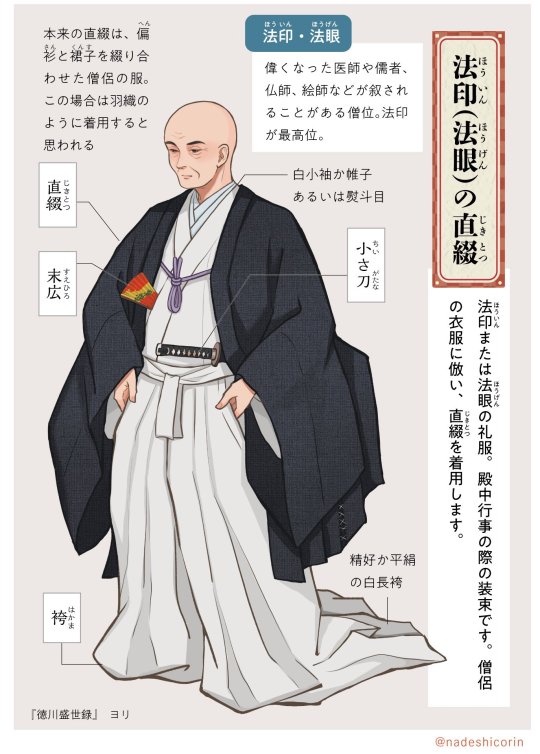
This outfit was worn for court events by Buddhist priests of the highest rank ( 法印 Hôin) and second highest rank (法眼 Hôgen). Those titles could also be also given to 儒者 Confucian scholars, 医師doctors, Buddhist 絵師 painters and 仏師 sculptors, etc.
直綴 Jikitotsu - type of monk robe, originally made by stitching together a 偏衫 henzan (monk robe covering the upper body) and a 裙子 kunsu (monk robe covering the lower body) together.
Overtime, jikitotsu came to be worn opened, more like a haori vest.
末広 Suehiro - a type of formal folding fan. TN: the fan drawn here ressemble more a 中啓 chûkei, as suehiro have curving ribs which don't seems to be the case here (find more about fan types here)
(長)袴 (Naga)bakama - hakama pants with long trailing legs, here made of hiraginu (plain silk)
白小袖 Shiro-Kosode - white kosode (=ancestor of the kimono)
/or/ 帷子 Katabira - thin garment made from hemp or raw silk (worn during Summer). Note that 経帷子 kyôkatabira designates a shroud (=the white kimono used to dress the dead).
/or/ 熨斗目Noshime - kosode (=ancestor of the kimono) with stripes/lattice pattern at waist area
小さ刀 Chîsagatana - small katana
"Companion" formal kimono
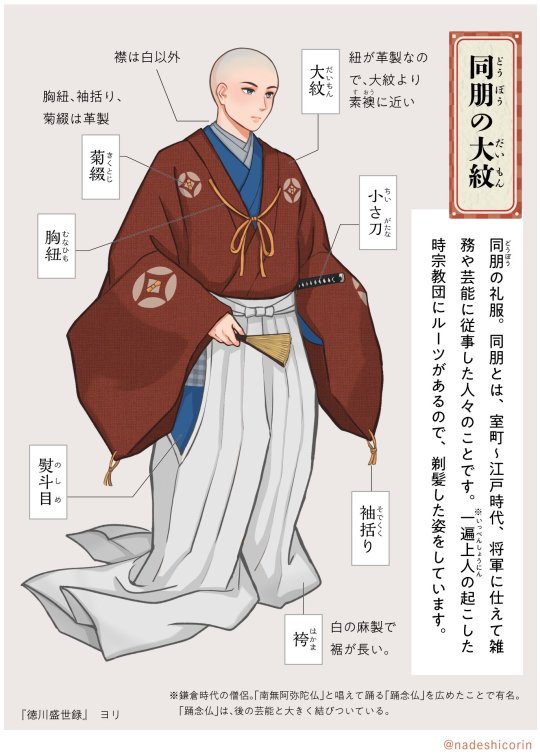
First people helping buddhist priests, 同朋 dôbô (lit. "companions) became overtime men attending on the Shogun, feudal lords and other high-ranked officals.
They were in charge of miscellaneous tasks (like cleaning, messengers etc.), or depending on their talents more skilled ones (dance, music, ikebana, tea ceremony etc.).
大紋 Daimon is a specific hitatare set, patterned with large 紋 mon (clan/family crests)
菊綴 Kikutoji - decorative tassel-like knots, first appeared on Heian nobility clothes. Here, those were leather ones
胸紐 Munahimo - chest ties, first appeared on Heian nobility clothes. Here, those were leather ones
熨斗目 Noshime - kosode (=ancestor of the kimono) with stripes or lattice pattern at waist area.
Also note the colored undergarments collars.
袖括 Sodekukuri - decorative sleeve ties. Originally appeared on Heian clothings (like kariginu, nôshi, etc) where they were used to tighten sleeve cuffs. Here, those were leather ones
(長)袴 (Naga)bakama - hakama pants with long trailing legs, here made of white linen
小さ刀 Chîsagatana - small katana
The Proto-haori

This outfit was the formal wear worn by lower class priests, scholars, doctors, artists, etc.
編綴 Hentetsu (lit. "stitched together") - a vest with large and long boxy sleeves, made from gauze or plain silk, most often black or dark brown. The chest straps were also made of the same fabric
It evolved from 十徳 jittoku (itself a variation of 直綴 jikitotsu, see above). First a casual wear for court nobles, and then spread to lower-class samurai who wore it over their kosode from Muromachi era and on.
Its use then reached other social classes during Edo period. Overtime and minor variations, it finally became known as our modern 羽織 haori
服紗(小袖) Fukusa(kosode) - a kosode (=ancestor of the kimono) bearing crest, and made from soft silk (like habutae or rinzu). In summer, it was a katabira (thin garment made from hemp or raw silk)
/or/ 熨斗目 Noshime - kosode (=ancestor of the kimono) with stripes or lattice pattern at waist area
#japan#history#fashion#samurai kimono#nadeshico rin#samurai#edo era#edo period#ressources#references#men kimono#着物#buddhist priest#monk#jikitotsu#henzan#kunsu#Suehiro#chûkei#nagabakama#kosode#Katabira#Noshime#Chîsagatana#dôbô#Daimon#Kikutoji#munahimo#Sodekukuri#Hentetsu
193 notes
·
View notes
Photo

Sengoku Period
The Sengoku Period (Sengoku Jidai, 1467-1568 CE), also known as the Warring States Period, was a turbulent and violent period of Japanese history when rival warlords or daimyo fought bitterly for control of Japan. The period falls within the Muromachi period (Muromachi Jidai, 1333-1573 CE) of Japanese medieval history when the Ashikaga shogun capital was located in the Muromachi area of Heiankyo (Kyoto). The beginning of the Sengoku period witnessed the Onin War (1467-1477 CE) which destroyed Heiankyo. The fighting that followed over the next century would eventually reduce the warlords to only a few hundred in number as the country was effectively carved up into princedoms. Eventually, one warlord rose above all his rivals: Oda Nobunaga, who set Japan on the road to unification from 1568 CE.
The Daimyo & Ashikaga Shogunate
The Ashikaga Shogunate (1338-1573 CE) held control of the central part of Japan, and the bureaucracy at the capital was relatively efficient, but the outer provinces were left semi-independent as local warlords or daimyo ruled their own lands how they saw fit. Local officials and estate managers such as the jito found it much more difficult to secure the taxes the state was due from landlords who now had no fear of any government reprisals. The daimyo (literally 'Great Names') were feudal lords who commanded personal armies of samurai or anyone else willing to take up arms and defend their lord's estates and help expand it.
Some daimyo were aristocrats with a long heritage of land ownership, others were military governors (shugo) who went independent from the weakened shogunate, and there were also new lords who were the sons of tradesmen who had gathered together a small army to simply take by force the land of others. The phenomenon of new rulers overthrowing the established order and of branch families taking the estates of the traditional major clans became known as gekokujo or 'those below overthrowing those above.' The consequence of all the upheaval was that Japan became a patchwork of feudal estates centred around their individual castles and fortified mansions.
In the absence of a strong central government - a situation only worsened by the shogun Yoshimasa's (r. 1449-1473 CE) decision to retreat to his Ginkakuji palace to contemplate the arts; the rule of law was very often replaced by the rule of force. The more powerful lords absorbed the lands of their weaker rivals and became known as sengoku daimyo. The warlords then passed on their position of strength to their male heir and so the position of daimyo became hereditary unless challenged by ambitious subordinate commanders. The wealth of the daimyo came from commerce, trade, and taxes imposed on those peasants who farmed on their estates. Daimyo may have been a law unto themselves but many of them did formulate law codes to better regulate the sometimes thousands of people under their command. These laws could cover anything from the prohibition of building castles and fortifications in their territory to measures that avoided wasting money on expensive theatre actors brought in from outside the daimyo's domain.
Continue reading...
42 notes
·
View notes
Text
This hairstyle is not chasenmage, and Sengoku samurai rarely wear this
I’m talking about this hair:

(screenshot from Kirin ga Kuru)
This is not specifically about Nobunaga or anything, but 90% of the Nobunaga I see in Taiga drama and movies usually has this hair style, and I want to talk about it. There were some drawing guides I’ve seen online that mistakenly label this hair as “chasenmage”, and it’s somewhat misleading.
Chasenmage 茶筅髷, literally meaning “tea whisk hair”, is one of the hairstyles commonly worn in the Muromachi and Azuchi-Momoyama period aside from the folded topknot (orimage/chonmage). The hair is tied tightly with strings, leaving a small tuft at the end, making it resemble a tea whisk. However, even a high-angled chasenmage doesn’t go as far as stick straight up like seen above.
That being said, I say they “rarely” wear the sticking-up style, not “never”, because this hairstyle is actually "real”. It’s not a made-up style invented by Kabuki or movies, it’s just... incorrectly applied. This hairstyle is called kanmuri-shita no motodori 冠下髻 or hitotsu motodori 一髻. It’s the hairstyle worn under the kanmuri (court cap):
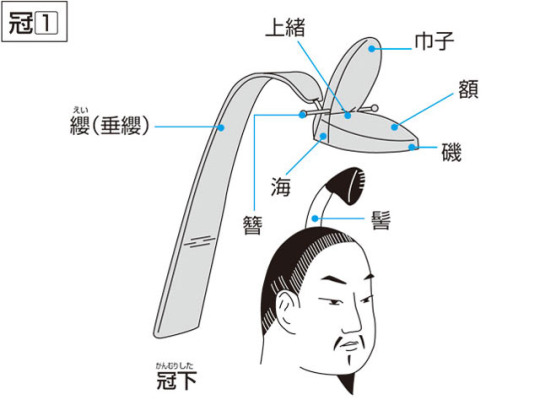
(image from Kotobank dictionary)
So if you want to be "accurate”, it’s fine Nobunaga or some other daimyou wears this hairstyle sometimes, but only if you’re showing they’re in the process of getting dressed or undressed from courtly attires (for meeting with the shogun or other courtly business).
It’s one thing if the character is the emperor or court nobles, as the caps are often part of the daily attire. It would make sense that they might keep their hair in kanmuri-shita style even in leisure. However, Sengoku daimyou wear their hair mostly in the folded topknot style, and there is no reason for them to constantly wear kanmuri-shita hair. And, once more, the kanmuri-shita is not the chasenmage that Sengoku samurai did frequently wear.

(Emperor Seiwa, shown with his hair in the kanmuri-shita style. From the Ban Dainagon Ekotoba 伴大納言絵詞 picture scroll)

Picture from Teijou Zakki 貞丈雑記, written by Ise Sadatake around 1763-1784, also describing that this hairstyle is meant to be worn under a hat (either an eboshi or a kanmuri, as mentioned above)
I can’t trace where/how it began, but at some point it seems that Kabuki actors starts wearing that hairstyle in their performances:

Ukiyo-e of Kabuki actors then influence ukiyo-e depictions of “historical events” of the Sengoku. Then, when people start making movies about Sengoku samurai maybe in the 50s and 60s, ukiyo-e and Kabuki costumes are probably the easiest source of reference, resulting in this long-standing “trend” to give Sengoku samurai this hairdo.

(Nobunaga wearing that now-“iconic” hairstyle in an ukiyo-e by Yōsai Nobukazu 楊斎延一)
Meta-wise speaking, it’s likely that studios maintain this “wrong” hairstyle to save on budget. It’s better to just reuse old wigs rather than spend more money to make a new batch of historically-accurate wigs. However, I don’t really see any reason for illustrated media maintaining this, other than “maybe the artist just didn’t know”. Unlike the image of Nobunaga wearing European armour, there is no real branding attached to this hairstyle, so there is no specific need to keep drawing this style. Far as I can tell, Sengoku enthusiasts are equally fine with seeing samurai wearing just a “normal ponytail”.
Or, if not, something like this:

The hairdo Koei likes to use for their Nobunaga’s Ambition portraits may not necessarily be an accurate chasenmage either, but it’s “less wrong” than the kanmuri-shita.
We end with what a “correct” chasenmage looks like, as depicted by paintings from the 16th century:

Some attendants from Nanban Byoubu by Kanō Naizen 狩野内膳 were shown wearing chasenmage.

Falconers from the Rakuchuu Rakugai screen, by Kanō Eitoku.
*) The third person behind them that I did not mark is angled oddly, so I wasn’t able to identify if that was a chasenmage (more stiff, secured with more strings) or just a “floppy ponytail”.

Modern illustration for clarity, provided by Kotobank online dictionary.
31 notes
·
View notes
Photo
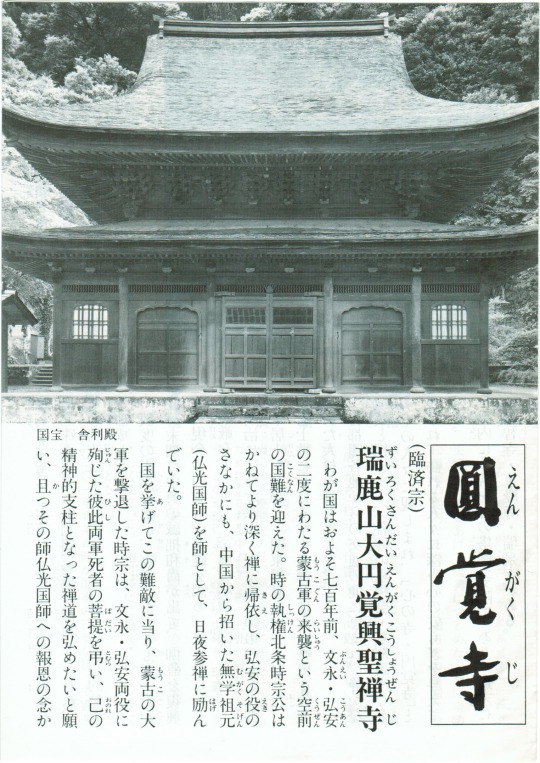
A pamphlet from Engakuji Temple (円覚寺) in Kamakura, Kanagawa Prefecture, founded in 1282 by the monk Mugaku Sogen (無学祖元) under the sponsorship of the shogunal regent Hōjō Tokimune (北条時宗), with the cover featuring the temple’s Shariden Reliquary Hall (舎利殿) dating to the Muromachi period (1336-1573)
Acquired at the temple May 1, 1995
#buddhist temple#神奈川県#kanagawa prefecture#鎌倉市#kamakura#円覚寺#engakuji#無学祖元#mugaku sogen#臨済宗#rinzai#zen buddhism#japanese history#北条時宗#hojo tokimune#pamphlet#ephemera#printed ephemera#paper ephemera#crazyfoxarchives
16 notes
·
View notes